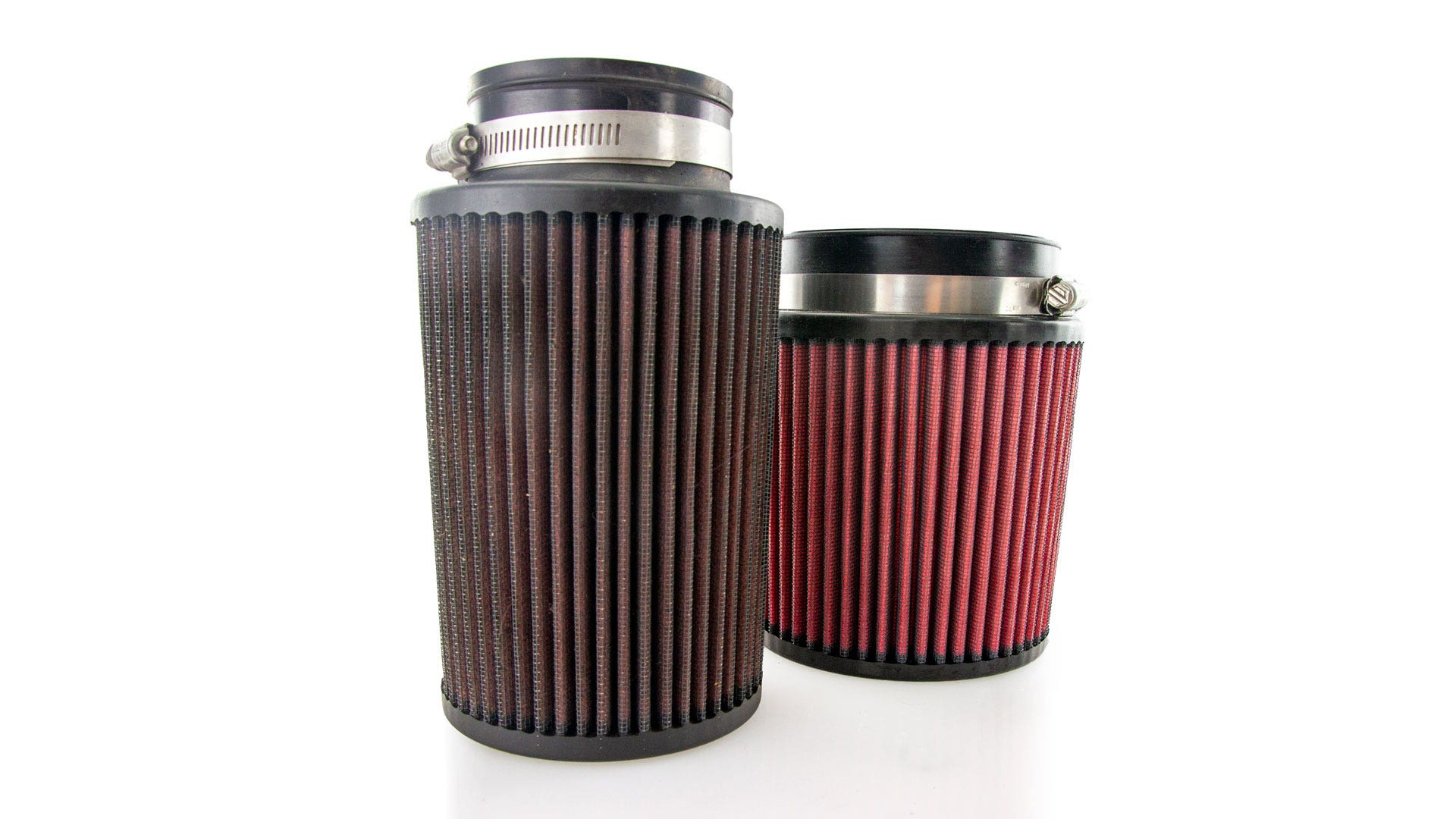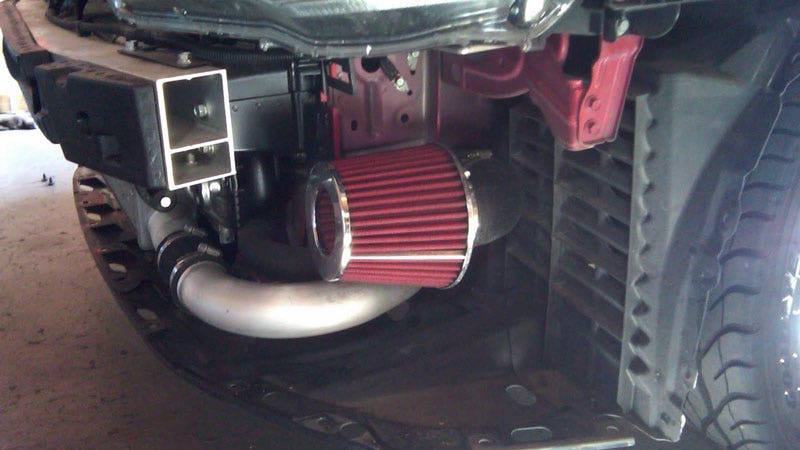
Mishi Goes Myth Busting: Performance Air Intakes - Part 1
Since the dawn of the internet, misinformation has been abundant. Somebody posts something their buddy's third cousin told them, it gets shared over and over, and eventually, it becomes a "fact." In the early days, it was easy to spot fishy information by the sixteen "FWD:" tags in the subject line of an email. Now, it's hard to tell what's authentic and what's just been passed down for so long that nobody can tell the difference.
One would think automotive culture would be less susceptible to these fabricated truths - vehicles are mechanical; they all have similar parts and work on the same principals of physics. Internal combustion engines all inject fuel into a closed cylinder, light it on fire, and use the expanding gasses to move a piston. But, even with all of these undeniable truths, there's just enough gray area for misinformation to thrive, especially regarding aftermarket modifications. Between ads, forums, and social media, automotive enthusiasts are constantly bombarded with ways to make their cars or trucks faster, more efficient, or better looking.

Of all the aftermarket parts, few are as controversial as performance intakes. Often referred to as "cold air" intakes, performance intakes are one of the first modifications many enthusiasts install, but they're also one of the most misunderstood. In this article, we'll break down how performance intakes work and bust some myths to help you choose the best intake for your car or truck.
Myth #1: All Performance Intakes are "Cold Air" Intakes
This is probably the most common misconception about aftermarket intakes. The truth, however, is that there are several different kinds of aftermarket intakes, each with their advantages and disadvantages. In general, we can break aftermarket intakes into three categories: direct-fit performance intakes, short ram intakes, and cold air intakes.

Direct-fit performance intakes are the most general category and what we focus on here at Mishimoto. These intakes usually mimic the stock layout while improving flow, power, and aesthetics. They are typically the easiest to install and have the best balance of performance and driveability. Two great examples of this type of intake are the Mishimoto 2018+ Jeep Wrangler JL 2.0T/3.6L performance intakes. For the JL, we analyzed the stock intake to see where we could improve flow, eliminated any unnecessary components, and ended up with an intake that flows over 30% better than stock. Both intakes install just like the stock intake, but on the 3.6L JL, the Mishimoto intake generated an average gain of 10.8 horsepower and 11.4 lb-ft of torque.
You likely noticed that we didn't include reducing air temperature in our list of improvements. When developing a direct-fit performance intake, we're limited to the envelope of the stock parts. That usually means it's nearly impossible to change the temperature of the intake charge without making other modifications to the vehicle. Luckily, the intakes on most modern vehicles are designed to pull in the coldest air possible without sacrificing driveability. We'll look at driveability again when we talk about cold air intakes.

The second type of intake is the short ram intake. These are the simplest and cheapest intakes, but they're also often the worst performing intake for everyday vehicles. A short ram intake, in essence, is just a pipe with a filter. The point of a short ram intake is to reduce restriction by making the intake tube as large and short as possible. The problem with short ram intakes, however, is often air temperature.

Short ram intakes move the filter as close to the engine as possible, which means they pull in hot air from the engine bay. Because hot air is less oxygen-dense than cold air, the ECU injects less fuel, and you can actually lose power from a short ram intake. Hot air also makes the fuel/air charge more prone to pre-detonation, also known as knock.

For vehicles that use a MAF-based fueling system, the lack of an airbox and the oversized piping often associated with short ram intakes can also pose a problem. Without an airbox, the intake receives inconsistent airflow and air temperature, which can throw off the fueling from second to second, effectively reducing efficiency and performance. The same can happen if the intake pipe is too large, which moves the MAF probe out of the middle of the airstream.
Overall, short ram intakes should be reserved for completely custom racing applications where there is no other option, and the vehicle will only need to perform for short periods before the intake becomes heat-soaked.
Finally, we've come to the famed cold air intake. As its name suggests, a cold air intake improves performance by pulling in cool ambient air. As we mentioned in the short ram intake section, cold air is more rich in oxygen, which allows the ECU to inject more fuel and make more power. Most cold air intakes move the filter outside of the engine bay to pull in the coldest air, usually either in the bumper or in the wheel well area. These intakes are often available in direct-fit applications, but before you buy one for your daily driver, there's a catch.
Moving the air filter to the bumper area or wheel well is excellent for pulling in colder air, but it also leaves the filter exposed to the elements, specifically water. Where direct-fit and even short ram intakes can be installed on a daily driver without any concern for the day's weather, cold air intakes require a little more consideration. Deep puddles and heavy rain have destroyed many engines in vehicles equipped with cold air intakes.
A small amount of water ingested by the intake may damage sensors or cause sputtering and misfires, but it can get much worse. While air is compressible, water is not. If the intake pulls in more water than the volume of the cylinder at top-dead-center (the top position of the piston), it can cause a catastrophic event known as hydrostatic lock or hydrolock. If your engine becomes hydrolocked, at best, it will stall, and you'll have to pull the spark plugs to clear the water out of the cylinders. Worst case scenario, a high compression ratio engine can bend the connecting rods, lift a cylinder head, or crack the block. Pre-filters that block some water are available for cold air intakes, but they can only do so much, so caution is still required when driving with a cold air intake.
Myth #2: Performance Intakes Improve Gas Mileage
Almost every day on the forums, we hear about drivers installing performance intakes to help improve gas mileage. Some even report an improvement of a few miles per gallon after an intake install. Unfortunately, however, intakes on modern fuel-injected vehicles do not improve gas mileage, and those reported increases are likely a placebo from driving more carefully.
Modern vehicles use an engine control module (ECU) or powertrain control module (PCM) to regulate the power output of the engine. Older control systems monitor how much air is being drawn into the engine via a mass-airflow sensor (MAF) and calculate how much fuel is needed to achieve a target air-fuel ratio (AFR). More air entering the engine means more fuel is injected to compensate and maintain a proper AFR. In this case, the engine will make more power, but will also use more fuel.
As emissions and gas mileage requirements have become more strict in the past several years, we've seen powertrain control systems shift to a strategy that targets a specific torque output while maintaining safe air-fuel ratios. These complex systems utilize controls like variable camshaft timing, ignition timing, and turbo dynamics to control the amount of air that's pulled (or pushed) into the engine. The upside of all those controls is improved base efficiency and gas mileage, but the trade-off comes when trying to improve performance. Because the PCMs in these vehicles are so strictly programmed, any improvements, including any that may improve gas mileage, will be negated by the computer to reach the specified torque output and AFR.

Even if performance intakes did improve gas mileage, the cost/benefit ratio is minuscule compared to merely driving conservatively. Most high-quality intakes that might have a chance of improving gas mileage cost about $300 to $400. If we compare that cost to the 1-2 MPG increase many owners report, given an average fuel cost of $2.23/gallon, it would take over two years to recoup the cost of an intake in fuel savings.
In any case, the best way to improve gas mileage in your fuel-injected vehicle is to ease up on the throttle, use high-quality fuel, and keep up with maintenance.
Myth #3: More Flow Equals Less Filtration
As with any myth, there's a hint of common sense to this misconception. The only way to let more air through is to let more dirt through, too, right? Not necessarily.
There are a lot of ways to improve flow with a filter media that is equivalent to the OEM filter. One of those ways is to increase the size of the filter. A larger filter will allow more air to flow into the intake without sacrificing filtration because the air is not forced through as small of a space.

Another way is by changing the filter material itself. Air is a fluid, so it will flow around the fibers of a filter, whereas dirt and dust will not. Filters made of a woven cotton material have staggered fibers that capture 99% or more of particles down to 5 microns but still allow air to flow through the weave. In contrast, a cotton gauze material will need to be less dense to flow more air because the fibers are not arranged uniformly. Air must change direction a lot more, so the only way to increase the airflow is to reduce density and sacrifice some filtration.

Oiled filters also improve filtration without sacrificing flow. The oil particles do not impede airflow, but they do capture and suspend smaller particles than would typically be captured by a dry media. So an oiled filter can be less dense, and therefore less restrictive than a dry filter.
Myth #4: Oiled Filters Will Damage Sensors

Oiled filters have gotten a bad name over the past several years due to some reporting oil transfer into the intake. In our experience, however, if the filter is oiled correctly (read: not over oiled), the oil should not make its way through the filter. We equip oiled filters on almost all of our shop vehicles, and we usually run them during R&D because they flow a little better than dry filters. In our 15 years of R&D, we have never had a fouled MAF sensor because of an oiled filter. We even made a video showing how to clean and oil your filter to make sure it's done correctly. Check it out below!
That being said, there are advantages to dry filters. Dry filters can be better for somebody who off-roads a lot or doesn't want the maintenance of re-oiling the filter. Like many performance modifications, you'll have to choose between more maintenance and performance, or a little less performance and convenience. Luckily, we offer many of our Mishimoto intakes with your choice of oiled or dry filter.
These are just a few of the myths surrounding performance air intakes. In our next myth-busting post, we'll dive into the rest of the common misconceptions about intakes, including how they can (or sometimes can't) improve engine performance, and why the stock intake in your vehicle may not be the best performing option. If you have more myths about intakes, or any other performance parts you'd like us to bust, feel free to drop them in the comments below!
Keep reading! Click here for Pt. 2
Thanks for reading!
-Steve









